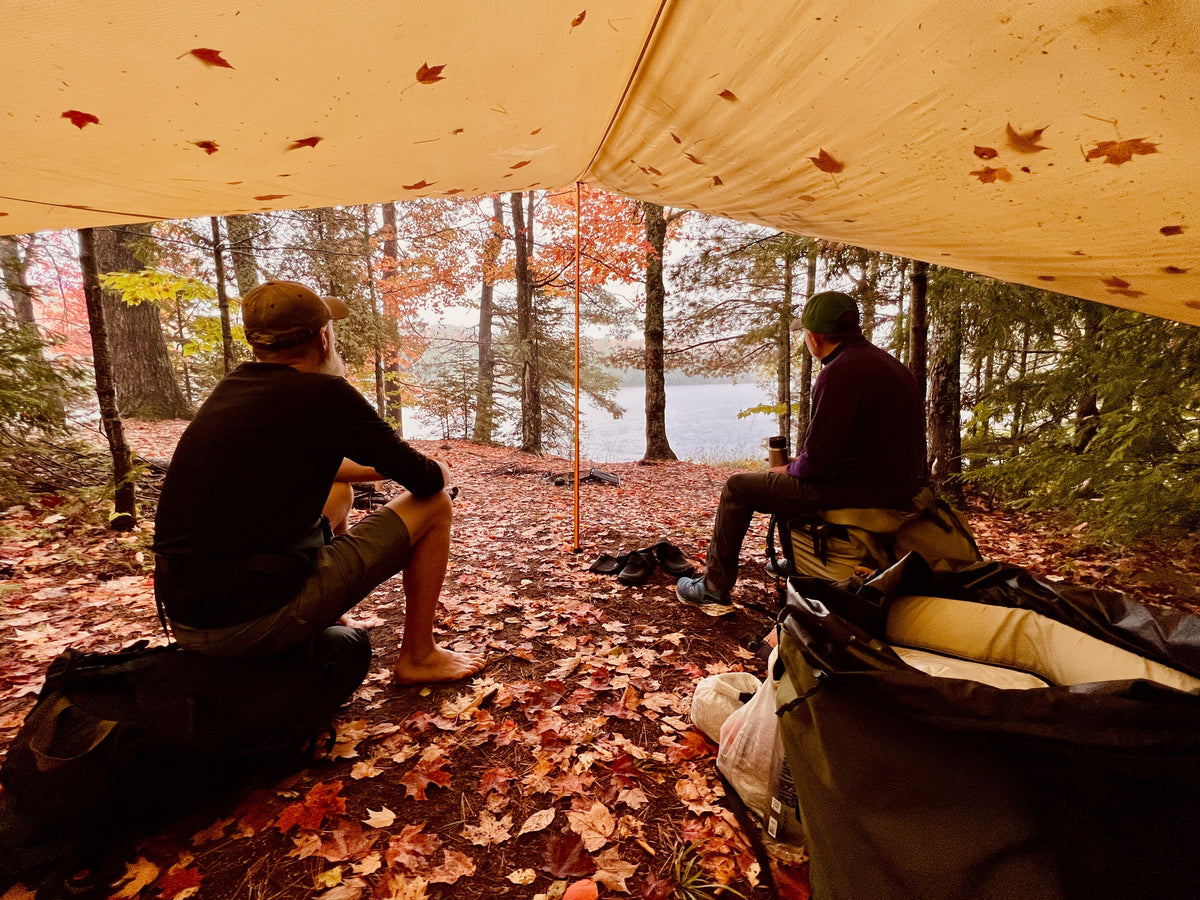

Let’s start here: 2023 was a wild ride. I left a hard-won career in academia to reclaim a life in Michigan’s Upper Peninsula where, although I would no longer have the trophy of tenure, I’d at least spend more time in the woods, by the lake, and paddling the many rivers that snake through perhaps my favorite topography on the planet.
Although I had lived in Marquette before, I had only explored the city’s surrounding terrain by bicycle and hiking boot. To help justify such a radical decision, though – one that prioritized people and place over profession – I was determined to get my first canoe. And use it a lot.
Joining the crew at Redleaf Designs sewing and cutting fabric was not only as antithetical to professoring at a liberal arts college as I could imagine, but also a great way to score my first boat: a vintage 1984 Wenonah K160, which true canoe nerds would know as a short-lived precursor to both the more famous J-boats and the Advantage.
I knew it as really tippy, really fast, and really light (28 pounds!). A hell of a starter boat, but that meant the learning curve would be steep and swift. With only a few months of paddling season left before my first winter back home, one in which many of the waterways would freeze solid, I got out as much as I could.
By October, the RedLeaf crew was anxiously watching forecasts and searching for windows to paddle. When a perfect fall weekend emerged with unseasonably mild temperatures, Jeremy, Chris and I quickly threw our essentials in dry bags, lofted three solo boats onto the racks, and carpooled 45 miles out to Big Island Lake Wilderness Area for a serene, portage-filled and people-less adventure.

The author and his Wenonah K-160 solo canoe.
The 23 lakes and over 5000 acres of Big Island Lake have a lot of the qualities of the Boundary Waters, minus the crush of tourism. We were one of only two cars in the parking lot at put-in, and we felt like we had the entire place – woods, water, wildlife – to ourselves.
Our plan included five portages to a campsite Jeremy and Chris knew well, with lots of picturesque paddling in between.

Portaging between Mid Lake and Coattail Lake in the Big Island Lake Wilderness. But wait: to portage. To leave the buoyancy, the fluidity, the flow of paddling on water only to strap down gear, hoist pack and boat onto one’s shoulders, and hustle heavy-laden over land. At Big Island Lake Wilderness Area, that hustle is frequently a steep climb to a ridge, a threading of long boats through dense forest, and then a steep descent back to water again. Gravity has a lot to say along the way. My approach was fast and light. Ninja-like. Minimalist and featherweight, just like on my bikepacking trips, although here, in my tippy Kevlar race boat, there was water to consider. I wrapped my small backpack in a plastic trash bag and meditated on stability.
Jeremy was also considerate of weight, but his ultralight packing included stuff he thought we might want collectively, like an ancient Moss Parawing tarp and poles – bulky, heavy, awkward. He was taking on pounds for the sake of the team.
Overkill, I thought to myself as I threw my boat and bag on my shoulders and rocketed over the first portage.

The start of the portage between Coattail Lake and McInnes Lake.
Chris, though, had a different approach, which included a waxed canvas backpack filled to 716.8 ounces of overflowing, as well as the heaviest canoe of the three, a Northstar Phoenix in a rugged IXP layup that sat weightily on his shoulders as he humped up the hill.
Just a quick note: all three of us are dads, yes, but also eager to be good dads, the kind who show up, who are present, who fully engage in the lives of our children.
So when Chris’s daughter got a part in Fairies Of The Night, and the cast called for goblins to jump and crawl and leap with ferocity, Chris snapped to, did his best goblining, and was so exuberant in his dancing and stomping that he gave himself a foot injury.
Portage by portage, the canoe and his pack and his aching foot challenged our progress. Chris is a dedicated trail runner in killer shape other than his hurting foot, but I took to sprinting over the ridges first, stashing my boat at the next put-in, then racing back to help him along.
Slow and laborious, yes, but part of the adventure. It was us. This place. These people and experiences that had drawn me away from a steady paycheck and job security in west central Indiana and thrown me back into a remote, rugged, altogether wild Upper Peninsula. To explore. To connect. To really live.
We made camp well before nightfall, which gave us ample time to optimize the site, build an inferno in the fire pit, and settle in for conversations that orbited around our partners and parenting and, of course, gear. Chris questioned his choices (in gear, not partners). Jeremy footballed over his hyperlite camp chair packed in its tiny bag as I sat in my much heavier, much bulkier throne. Words like Dyneema and composite and telescoping titanium hovered in the night air until we headed to sleep not to the sound of summer’s buzzing mosquitoes and black flies, but to leaf rustle, the gentle ripple at water’s edge, and eventually the steady drip and patter of soft rain.
By morning, it was clear why we were the only overnighters in the wilderness area. We woke to a thunderstorm-filled riot, cloud-to-ground strikes, and a Doppler read on Jeremy’s phone that showed how the storm front kept churning off nearby Lake Superior and resurrecting itself over and over again directly above our campsite.

The cold, moist air from Lake Superior was lifted by the warmth of the land, creating a conveyor belt of thunderstorm that rolled over us for an entire morning.
We waited. Waited some more. Tried to stop thinking about waiting and then helped Jeremy set up the old Moss Parawing tarp which, suddenly, seemed like the most essential gear any of us could have packed.
From our soggy perch under that tarp we saw a solo canoeist on the horizon, shrouded in thick mist, paddling slowly toward us with a decent j-stroke as a backdrop of lightning snapped in the distance.
A ranger? I thought. Who else would be crazy or cavalier enough to hit the water in these conditions? And is that a conductive carbon paddle he’s wielding?
Turns out it was Jonathan from Indianapolis, only a hop and short skip from the home I had just left, who had traveled all those miles to be there, on the water, ostensibly in my new backyard.
Jonathan was waterlogged but cheerful, and admitted that a little voice in the back of his mind kept saying: Dude, are you sure you should be out in these conditions? Alone?
But yes, he was safe, so happy to be there, marveling that our own drive was under an hour. That’s when we felt the barometric shift that meant we might have a tiny window to hightail it home. The sheet-rain roar turned, just for a moment, to a whisper.
“Let’s do it,” said Chris, who was undoubtedly thinking of the five portages ahead. His feet. His family back home.

Moving quickly when the storms shifted to the North for a bit.
We left in a staggered pattern, no one closer than 150 feet to the next. Just in case. And here’s the thing: as a (former) English professor, I know how easy it is to strain a metaphor, to stretch language into overwrought lines that heavy-handedly color our stories. I’ve made those notes in the margins of a thousand student essays.
But as we portaged our way out lake by lake, ridge by ridge back to the last stretch of water, I swear I couldn’t help thinking about my own recent journey, from the relatively calm flow of what I thought was going to be my lifelong dream job, to the tumultuous, heavy lift of dismantling a life and rebuilding it anew, to that day’s final paddle in my tippy Kevlar canoe moving swiftly toward the Big Island Lake Wilderness take-out, feeling – at least for that delicious moment – all together buoyant.

The author (right), Chris (center), and Jeremy (left), at the take out.

